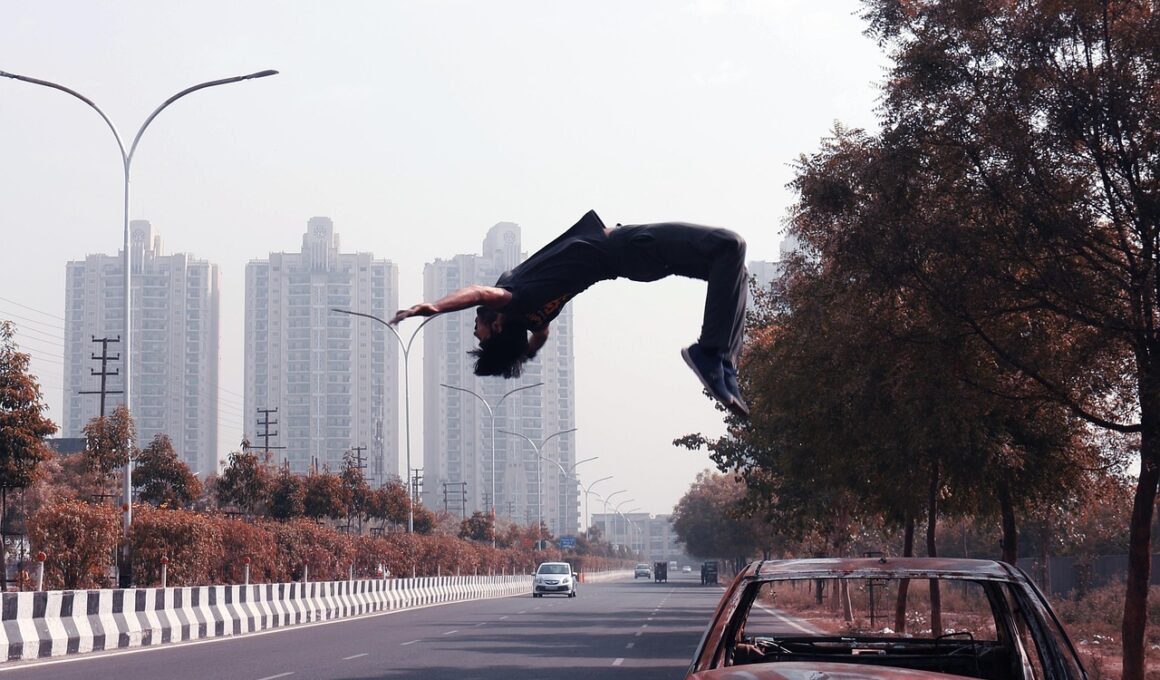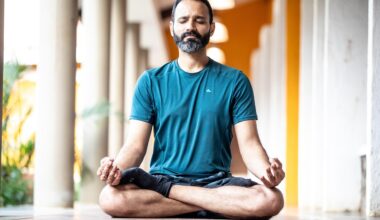Parkour Drills to Enhance Agility and Speed
Parkour is an incredible discipline that fosters physical fitness through movement, creativity, and skill. Participating in parkour involves developing agility and speed, alongside strength and flexibility. To help enhance these attributes, dedicated drills can be undertaken that focus on specific movements typical in parkour. Before beginning any workout, it is crucial to properly warm up, preparing the body for rigorous activity. This decreases the risk of injury and optimizes performance. Start with dynamic stretches and movements to energize your muscles. It’s essential to incorporate various exercises targeting different muscle groups to build a strong foundation. As you progress, consider integrating techniques like vaulting and wall runs into your routine. Consistency is key; trying to practice at least three times a week will ensure noticeable improvements. Utilize your environment creatively, transforming everyday obstacles into training opportunities. Not only does this make your workouts more enjoyable, but it also hones your skills in adapting quickly to different scenarios. Parkour drills can be easily adapted to your fitness level, making it accessible for everyone.
Essential Drills for Agility
To cultivate agility, some essential drills involve quick footwork and lateral movements. Ladder drills are excellent for improving coordination; they require navigating through a series of markers or rungs in a fast, controlled manner. Begin by setting up an agility ladder or use tape to create a grid on the ground. Perform a variety of movements such as high knees, side shuffles, and in-and-out steps. Start slowly, focusing on precision and form before gradually increasing speed. Another effective drill is hopping from side to side over a cone or small barrier. This not only promotes agility but also strengthens the legs and enhances balance. Additionally, implementing plyometric exercises like box jumps or burpees will contribute to explosive power and speed. Incorporate regular sprint intervals into your routine, alternating between short bursts of speed and active recovery. These efforts will teach your body to move quickly in various directions. Lastly, practicing parkour-specific skills, like precision jumps or wall runs, not only improves agility but makes training more engaging. Challenge yourself progressively, ensuring a steady development.
Another beneficial method to improve your agility is through partner drills. Having a training partner introduces an element of unpredictability in movements while fostering healthy competition. For instance, practice mirror drills where one partner leads movements while the other tries to replicate them quickly. These drills can establish rapid reflexes and enhance agility. You can also engage in tag games in open spaces, focusing on evasion and fast directional changes. These activities emphasize the fun aspect of training while effectively building speed and agility. Incorporate not only these physical drills but also agility-focused games that encourage movement imagination and creativity. Another great activity is balance training; using equipment like balance boards or beams can significantly increase your agility. Regularly practicing balancing exercises would promote stabilization while strengthening core muscle groups. Ultimately, involve various types of movements ensuring your workouts remain appealing and diverse. With these drills, monitoring your progress is beneficial; keep a log to track improvements over time. Stay committed and maintain a gradual increase in difficulty to keep challenging yourself effectively throughout your training.
Strength Training or Conditioning
While agility is pivotal for parkour, enhancing overall strength is equally crucial for developing both speed and performance. Engaging in strength training targets core, legs, arms, and overall musculature, boosting performance. Exercises like squats, deadlifts, push-ups, and pull-ups are excellent. Building muscle endurance will also support your parkour practice. Implement these movements into your routine at least two to three times weekly, varying the number of reps and sets. Beyond traditional strength exercises, incorporating resistance tools such as bands or weights can challenge the muscles uniquely. Consider utilizing functional movements mimicking parkour actions to parallel your training. This includes jumping, climbing, and explosive bursts. Integrate exercises like kettlebell swings or medicine ball slams, which enhance power and conditioning. Moreover, cross-fit training complements parkour practice since it increases strength while embodying high-intensity elements. Circuit training can also maximize endurance: alternating various strength exercises with minimal rest. Always allow ample recovery time between working muscle groups. Finally, focus on engaging your core; it is essential to maintaining balance when performing dynamic parkour movements.
Flexibility directly impacts your parkour performance and helps avoid injuries. All parkour practitioners must include a flexibility regimen within their training routines. Dedicate at least a portion of your workout to stretching or flexibility exercises. Start with dynamic stretches during warm-ups before easing into static stretches post-workout. Common stretches targeting the hips, hamstrings, and shoulders will nurture movement efficiency. Additionally, incorporating yoga sessions can vastly improve flexibility, balance, and mindfulness, which greatly influences your maneuverability in parkour. By systematically enhancing your flexibility over time, you will also observe improvements in your overall muscle elasticity and performance during drills. Establish a routine focusing on different muscle groups, ensuring you stretch both before and after sessions. Moreover, explore different types of stretching, including PNF (Proprioceptive Neuromuscular Facilitation), advanced stretching for faster results. Target problem areas during flexibility training will significantly benefit muscle recovery too. Once you feel more adequate flexibility, combine these stretching drills with your agility drills for maximum effectiveness, allowing for a comprehensive training approach that includes all key elements necessary for parkour.
Mindset and Concentration
Your mindset while training can greatly influence the success of enhancing your agility and speed through parkour. A positive mindset and mental preparation are fundamental in overcoming challenges faced during drills. Consistent training develops familiarity, leading to enhanced focus. This mental element effects not only performance but also how an individual approaches obstacles. Fostering self-belief is crucial; when you believe in your capabilities, you’ll push limitations further. There are several techniques you can utilize to enhance mental preparation, including visualization. Visualize executing movements successfully before attempting them. By nurturing a focused attitude towards training, you’ll further streamline your learning curve and reduce anxiety when attempting complex drills. Try mindfulness techniques as well, such as meditation, during your rest days. They can help center your thoughts and improve overall concentration. Finally, engage with visual stimuli, like watching experienced practitioners, will help familiarize the movements before trying them personally. Remember to celebrate small victories during the training process to maintain motivation. Your mindset sets the foundation for your parkour journey, leading to greater engagement and success.
Finally, integrating cross-training into your parkour journey can be a game changer for developing agility and speed. Engaging in other athletic activities complements your effort, encouraging diverse skill set acquisition. Consider adding activities like martial arts or dance, which both promote coordination and body control. Alternatively, sports such as soccer or basketball accentuate quick lateral movements, beneficial in honing speed. These additional practices not only build physical capabilities but also maintain excitement and prevent burnout from repetitive routines. Moreover, working with diverse athletes introduces new perspectives and enhanced techniques outside the realm of parkour. Try participating in workshops or classes specializing in movement and athletics. These experiences could provide useful insights and techniques to apply into your parkour training. Remember, the objective is to maintain overall enjoyment in your fitness journey. Above all, experimenting with various styles and activities will continually challenge your body, enhance versatility and ultimately improve agility in movements. Embrace challenges wholeheartedly; enjoy the process of learning, and over time, you will naturally excel at parkour and its related movements.


